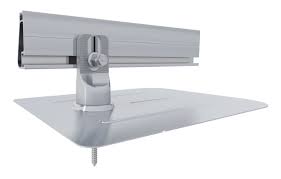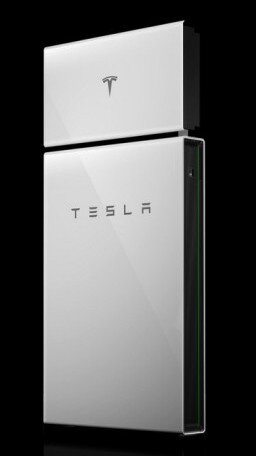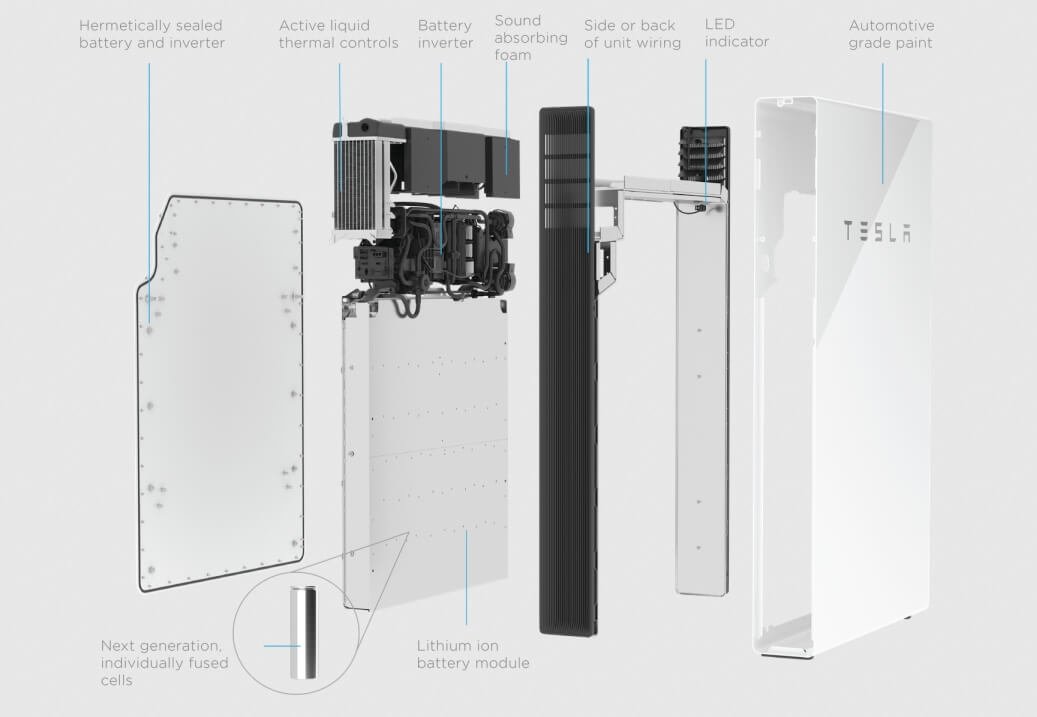-


Tesla Powerwall+ (3)

The Powerwall lithium battery system from Tesla Energy has made a big impact in the solar world and pushed home energy storage into the mainstream. Tesla took the energy storage world by surprise with the release of the first generation Powerwall 6 years ago. This unique DC-coupled battery had a much smaller 6.4kWh capacity and was the first high-voltage battery for home use. In comparison, the second generation Powerwall 2 released in 2016, which has over double the storage capacity and includes an integrated battery inverter-charger giving it much more power and flexibility. The latest iteration in the Tesla home battery series is the new Powerwall+ (plus), The new Powerwall+ is essentially the Powerwall 2 battery system with an integrated solar inverter making it a complete all-in-one solar energy storage system.
Powerwall Plus main features and specifications

Tesla Powerwall+ (Plus)
-
13.5kWh usable storage capacity
-
AC-coupled battery with integrated inverter/charger and Solar Inverter
-
7.6kW Solar Inverter with 4 MPPTs = Max solar capacity 12.9kW
-
On-grid power rating = 5.8kW continuous, 7.6kW peak output rating
-
Off-grid power rating = 7kW continuous, 10kW peak output rating
-
Advanced liquid thermal management system
-
10-year warranty with a minimum 70% retained capacity*
-
Price: US$12,800 - TBC - Plus backup gateway may be required**
-
Available in the US only, not available in Australia or the EU
** Subject to change. Does not include installation, solar panels, or additional components.
See the full Tesla Powerwall+ (plus) specification datasheet
Battery Inverter Included
The Powerwall is an AC battery, meaning it has an integrated AC to DC inverter-charger; this has several advantages and disadvantages. One main advantage is the ability to be easily retrofitted to homes with an existing solar installation. Since it has an inbuilt inverter, another advantage is that it can be installed without solar and used solely for backup power purposes.
The base Powerwall has a moderately high power rating of 5kW continuous and a peak output of 7kW, while the Powerwall Plus is slightly higher at 5.8kW continuous with a 7.6kW peak. The power output is generally well suited to meet the requirements of an average home, which often has several high-powered appliances running simultaneously. The 7kW peak power rating is reasonable, but it can only maintain the peak output for 10 seconds; this means it's only suited for brief power (startup) surges and not well suited for off-grid installations.

Tesla Powerwall 2 battery specifications - Image credit Tesla
Increased Power output via software update
Earlier in 2021, Tesla announced a new software update that can increase the continuous and peak power rating by up to 50% on some later model Powerwalls. However, the increased power is only available at ambient temperatures up to 30C. This was enabled after analysing years of operational data and determining there were no detrimental effects. Several competing battery systems above 10kWh can output up to 8kW continuous and 10kW+ surge, so it’s not surprising the Tesla Powerwall had some hidden capacity available.
Liquid-Cooled
The Tesla Powerwall is still the only battery system on the market to incorporate a liquid thermal management system that enables it to operate in a wide range of temperatures from -20 to +50°C. Although, like most lithium battery systems, it is still likely to derate or reduce its power output at ambient temperatures above 40°C. Power derating is common for most lithium-ion based batteries, but Tesla's liquid cooling enables the Powerwall to expel more heat under high loads and during rapid charging, which should result in a longer life span and better performance at higher temperatures.

Exploded view of the Tesla Powerwall 2 showing the liquid cooling system and heat exchange system (top left)
Low-temperature performance
Tesla’s thermal management system also enables the Powerwall to charge at temperatures below freezing which is when many other lithium batteries suffer from severely reduced charge rates. Lithium battery cells cannot charge properly below 5°C due to reduced diffusion rates on the anode. Thanks to the unique thermal management system, the Powerwall is able to preheat its cells at low temperatures, known as preconditioning - “When temperatures are below freezing, preconditioning turns on and heats the Powerwall to improve charging performance”. The Powerwall will generally use grid power to preheat the cells, although, in a blackout, it can also use some of the stored energy to heat the cells. Note, this may be problematic if the battery is in a low state of charge.
Multiple Powerwalls for greater storage needs

The Powerwall 2 can be stacked for more storage capacity with up to 3 modules per phase
For larger capacity systems, the Powerwall can be set up in split or 3 phase configurations with up to nine Powerwalls linked together. Although, the additional Gateway unit is required for these complex installations. The maximum capacity per phase is 3 Powerwalls which provides an impressive 40.5kWh of total storage capacity, which is more than enough for most standard households. However, considering EV charging from home can use in excess of 50kWh, it has the potential to charge an EV primarily using stored energy.
Additional Solar Inverter Required
The Powerwall 2 is an AC battery (AC in and AC out), so in order to function together with a solar array, the Powerwall system requires a separate solar inverter (Refer to the diagram below). One advantage of this is the solar inverter can be 'almost' any model since it operates independently of the Powerwall.
AC-coupled battery systems like the Powerwall can be easily retrofitted to homes with an existing solar installation, but they are slightly less efficient compared to the common DC-coupled battery systems. This is due to losses in the conversion from DC to AC power - first, the DC solar energy is converted to AC by the solar inverter, then back to DC to be stored in the battery, and finally back to AC when it is needed by the appliances (with typically 3-4% losses in each conversion). This adds up to approximately 90% round trip efficiency compared to around 95% efficiency with a common DC-coupled battery.

Basic layout diagram of an AC coupled Tesla Powerwall 2 with a common solar inverter
Tesla Powerwall 3
While it’s not called the Powerwall 3, the new Powerwall+ (Plus). The all-in-one systems make installation much easier and require less space to install. For example, Redback Technologies, Sonnen, Senec and Alpha ESS supply all-in-one systems with backup power and additional pass-through power as standard. I would expect the next generation Powerwall 3 to move in the same direction and offer a complete solar/battery/backup solution”
Powerwall Plus Solar Battery System
After a teaser a few months ago, Tesla has officially listed the new Powerwall+ (Plus) on the US Tesla website with some impressive features. The successful Powerwall 2 has been on the market for five years with a few minor tweaks to the available capacity and weight. It’s not surprising the new Powerwall+ is built on the Powerwall 2 platform with an integrated Tesla solar inverter to create a complete all-in-one system. While the storage capacity remains the same at 13.5kWh, the power rating has increased substantially to cater for dedicated off-grid and backup use. The power ratings are up from 5kW continuous and 7kW peak, to 7kW continuous and 9.6kW peak in off-grid mode. On-grid power ratings have also increased slightly to 5.8kW continuous and 7.6kW peak.

Tesla Powerwall+ specifications
The inbuilt solar inverter is essentially the same as the 7.6kW inverter described earlier but repackaged to fit the Powerwall form factor. The solar inverter features four individual string inputs or MPPT’s which operate with four different strings of solar panels. Based on the specifications, we determined the inverter could potentially operate with a sizeable 16kW rooftop solar array using up to forty modern 400W solar panels, or ten panels per string. However, the Tesla datasheet specifies the maximum solar DC to AC ratio is 1.7, which equates to a maximum of 12.9kW.
Off-grid use
For those hoping to purchase a Powerwall and go off-grid, the system is only off-grid capable when installed in a protected location with an adequately sized solar array. Most modern off-grid homes require at least 7 to 10kW of solar, depending on the location. However, due to the maximum 5kW charge rating, each Powerwall is limited to a maximum of 5kW of solar (solar inverter size), so more than one Powerwall will be required for most applications - learn more.
To power a modern off-grid home, two or three Tesla Powerwalls will be required, plus a backup power source such as a generator is required in most colder locations with short winter days. Note, the Powerwall system was originally designed to operate as a grid-connected energy storage system that can provide short-duration backup until the battery is depleted; it was not intended to function as a dedicated off-grid power system. If anyone is planning to build an off-grid home using a Powerwall or similar, I recommend reading our detailed off-grid system guide first.

Typical system layout with the Powerwall and solar inverter feeding power the home - Image credit Tesla
The Tesla App
The Tesla app enables real-time monitoring of grid energy usage, battery state of charge and solar generation in a simple, easy to use interface. The app is common to all tesla products and provides a seamless interface between EV control, solar generation and energy storage.
The Tesla app provides 4 different Powerwall control modes
-
Self-Powered mode - Increases self-consumption of solar by storing excess generation.
-
Time-based control - Prioritises energy storage or consumption based on your electricity usage tariffs to reduce bills and save money.
-
Storm watch - Automatically charges the Powerwall in the event of a major storm or blackout.
-
Vehicle charging during a power outage - Enables the Powerwall to Tesla EV’s to dynamically adjust the charge rate to prevent overloading the system during a power outage.

Warranty
The Powerwall warranty is 10 years with 70% minimum retained capacity (solar self-use and backup use only) which is much better than the original Powerwall 1 warranty. However, if charged using solar plus low tariff (off-peak) energy, then the number of 'daily' cycles could be greater than one and this can increase cell degradation. This is where the warranty details come into effect in regards to 'Operation Limitation' - refer to the image below. The ‘aggregate throughput’ is the total amount of energy measured at the battery AC output which is 37.80 MWh. This equates to roughly 80% of the battery capacity, or 10.5kWh, being discharged every day of the year. However, due to many households not needing to discharge the battery fully during mild weather and allowing for times when buildings are unoccupied, this is generally unlikely to happen in a real-world scenario.
Keep in mind that all batteries slowly reduce capacity over time as they are charged and discharged, and this is a normal part of the cell aging (degradation) process. Lithium (NMC) batteries typically have 60% to 70% retained capacity after 10 years. A few lithium batteries chemistries such as LFP and LTO specify a lower degradation rate but a higher upfront cost so it's a matter of balancing the cost/benefit. See the full Powerwall Warranty details here.

-
-



Description
FranklinWh 15Kw Full Home Battery Backup - Reliable Power Solution for Your Home (Franklin Home Power Solution (“FHP”))
The FranklinWh 15Kw Full Home Battery Backup is the ultimate solution for uninterrupted power supply in your home. This powerful battery backup system provides up to 15 kilowatts of continuous power, ensuring that your home remains fully operational during power outages or emergencies. The FranklinWh 15Kw Full Home Battery Backup is designed for long-lasting durability and reliability, with high-quality components and cutting-edge technology. The battery backup system features advanced safety features, including overcharge protection and short-circuit protection, ensuring that your home and family are always safe and secure. The FranklinWh 15Kw Full Home Battery Backup is easy to install and operate, with a simple interface that allows you to monitor and control the system with ease. The system is also highly efficient, with a high energy conversion rate that ensures maximum power output and minimum energy waste. With the FranklinWh 15Kw Full Home Battery Backup, you can rest easy knowing that your home is always protected and that you have a reliable source of power during emergencies or power outages. Whether you live in an area prone to natural disasters or simply want the peace of mind that comes with having a backup power source, the FranklinWh 15Kw Full Home Battery Backup is the ideal choice for your home.Designed to meet homeowners’ future needs today, Franklin Home Power goes well beyond the demand for safe, reliable backup. Our powerful performance stems from integrating the highest AC battery capacity with the industry’s most intelligent controls.a. aPower is the AC battery with a built-in advanced inverter.b. aGate is the energy management device connecting the grid,the loads, the generator, and the solar system.c. FranklinWH App allows for seamless monitoring of your wholehome energy.FEATURES
Reliable Exceeds performance standards, backed by 12-year warranty Scalable Highest system density allows up to 15 units for 204 kWh1 Hassle-Free Remote monitoring and user-friendly app limits O&M Flexible Technology-agnostic system can be used with any solar inverter Simplified Pre-assembled for fast, easy one-step installationSPECIFICATIONS
Energy Capacity Range (kWh):13.6-204 Aggregate Throughput :43MWh Product Warranty: 12 Years No. Mmodules: 1-15 Battery Type :Lithium Iron Phosphate Manufacturer (Brand): FranklinWH Nominal Voltage: 120V/240V, 60Hz
DATA SHEET
-

 Pitched Roof Mounting Every component in the IronRidge Flush Mount System has been tested to the limit and proven in extreme environments: rain, wind and snow. Our rigorous approach has led to unique structural features, such as curved rails, universal fastening objects and reinforced flashings. All of our products are fully-certified, code-compliant, listed to UL 2703 and backed by a 20-year warranty.
Pitched Roof Mounting Every component in the IronRidge Flush Mount System has been tested to the limit and proven in extreme environments: rain, wind and snow. Our rigorous approach has led to unique structural features, such as curved rails, universal fastening objects and reinforced flashings. All of our products are fully-certified, code-compliant, listed to UL 2703 and backed by a 20-year warranty.












